Browse All Articles > Time Zones, Windows, and Microsoft Office - Part 2
Listing and selecting time zones in Microsoft Access and Excel is not straight forward. In the previous article was shown how to retrieve the time zones of Windows. Here will be demonstrated how to create tables to store these and how to display and select a time zone in Microsoft Access and Excel.
Time Zones, and Microsoft Office - Part 2 by Gustav Brock under a Public Domain Dedication (CC0) license
This is the second article about maximising the usage of time zones in Windows with Microsoft Access and Excel.
The first covers the VBA code to retrieve the time zones: Time Zones, Windows, and VBA - Part 1.
Presenting the time zones and their bias in Microsoft Access
The last topic in the first article was how to format the bias of a time zone, and the function FormatBias for the purpose was discussed. With this tool - to format the bias for display - it is time to present the time zones and their bias or other information to the user.
A ComboBox or ListBox is well suited for the purpose and - as the list isn't that large and we have no table to use as a row source - a callback function is the perfect choice for filling the ComboBox or ListBox.
How to create a callback function is a lecture on its own, so browse for a guide, if you are not familiar with this (often labelled) hidden gem of Access. Read the guide and peruse the example code here. It will pay off.
The callback function here will list the time zones and their MUI:
' Common constants.
' Default column width.
Private Const DefaultColumnWidth As Integer = -1
' Hidden column width.
Private Const HiddenColumnWidth As Integer = 0
'
' Callback function to list the timezones of Windows.
'
' Example for retrieval of selected value:
'
' Dim TimezoneName As String
' TimezoneName = Me!ControlName.Value
'
' Typical settings for combobox or listbox:
'
' ControlSource: Bound or unbound
' RowSource: Leave empty
' RowSourceType: CallWindowsTimezones
' BoundColumn: 1
' LimitToList: Yes
' AllowEditing: No
' Format: A valid format for date values
' ColumnHeads: True or False. If True, do specify constant Headers
' ColumnCount: Don't care. Will be set by the function
' ColumnWidths: Don't care. Will be overridden by the function
'
' 2019-12-12. Cactus Data ApS, CPH.
'
Public Function CallWindowsTimezones( _
Control As Control, _
Id As Long, _
Row As Long, _
Column As Long, _
Code As Integer) _
As Variant
' Fixed constants.
'
' Count of columns in the control.
' 0: Key. Name of the timezone.
' 1: Mui.
' 2: Custom display.
Const ColumnCount As Integer = 3
' Customisable constants.
'
' Separator for use in Headers.
Const Separator As String = ";"
' Count of items in Headers must match ColumnCount.
Const Headers As String = "Name" & Separator & "Mui" & Separator & "Timezone offset and locations"
Static ColumnWidth(0 To ColumnCount - 1) As Integer
Static RowCount As Integer
Static Entries() As TimezoneEntry
Dim Entry As TimezoneEntry
Dim Value As Variant
Select Case Code
Case acLBInitialize
' Control settings.
Control.ColumnCount = ColumnCount ' Set the column count of the control.
ColumnWidth(0) = HiddenColumnWidth ' Hide the bound (value) column.
ColumnWidth(1) = HiddenColumnWidth ' Hide the Mui column.
ColumnWidth(2) = DefaultColumnWidth ' Set the width of the display column to the default width.
' Value settings.
If RowCount > 0 Then
' Entries has been retrieved.
Else
Entries = RegistryTimezoneItems()
SortEntriesBiasLocations Entries
' Count of rows to display including column headings.
RowCount = 1 + UBound(Entries) + Abs(Control.ColumnHeads)
End If
' Initialize.
Value = True ' True to initialize.
Case acLBOpen
Value = Timer ' Autogenerated unique ID.
Case acLBGetRowCount ' Get count of rows.
Value = RowCount ' Set count of rows.
Case acLBGetColumnCount ' Get count of columns.
Value = ColumnCount ' Set count of columns.
Case acLBGetColumnWidth ' Get the column width.
Value = ColumnWidth(Column) ' Use preset column widths.
Case acLBGetValue ' Get the data for each row and column.
If Control.ColumnHeads = True And Row = 0 Then
' Display a header.
Value = Split(Headers, Separator)(Column)
Else
' Display a value.
Entry = Entries(Row - Abs(Control.ColumnHeads))
Select Case Column
Case 0
Value = Entry.Name
Case 1
Value = Entry.Mui
Case 2
Value = FormatBias(Entry.Bias, True, True, Entry.Name) & " " & Entry.Locations
End Select
End If
Case acLBGetFormat ' Format the data.
' Use default (standard) format. ' Apply the value or display format.
Case acLBClose ' The form closes or the control is requeried.
' no-op.
Case acLBEnd ' The form closes or the control is requeried.
' no-op.
End Select
' Return Value.
CallWindowsTimezones = Value
End FunctionThe implementation is extremely simple. In the properties of the ComboBox, set the RowSourceType to the name of the function:

When launched, the function will itself set the other crucial properties of the ComboBox (see section acLBInitialize in the code above).
Now, open the form, click dropdown to make a selection, and you will see the equivalence to the list of Windows 10:
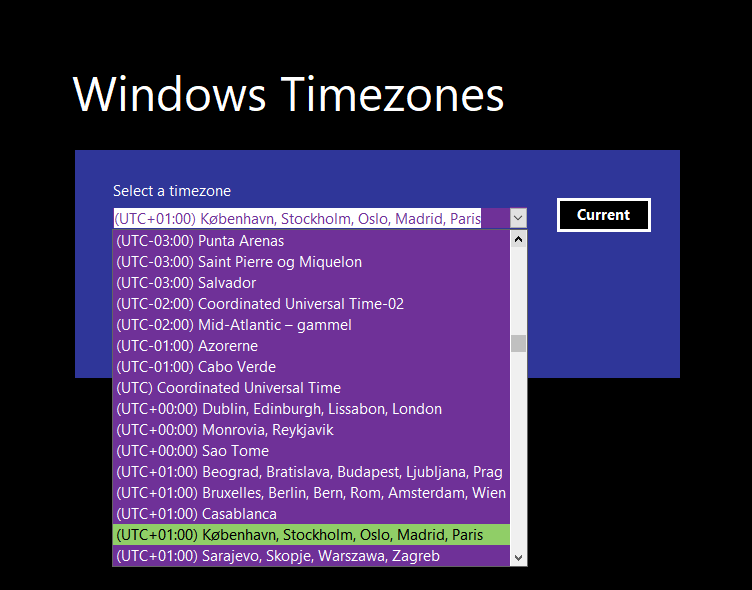
and - having made a selection - the MUI and the Name (which you may recall is the true key) of the selected time zone are displayed:
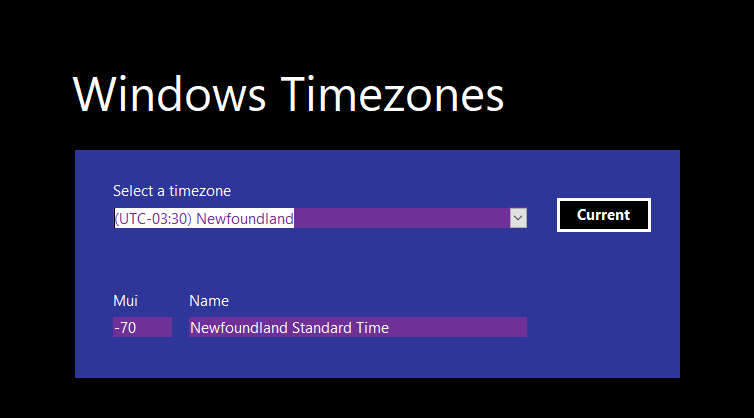
You may wonder, why all MUIs are a negative number, but no documentation can be found that explains or just indicates the reason. It has just happened to be so.
Of course, the callback function can be modified or expanded to return any other information about the time zones.
Tables for extensive calls, sorting, filtering, and searching
If time zones and their data are expected to be heavily used in an application, it will be more convenient to normalise them and keep them in two tables where the child table holds the locations. Then the data can be accessed in a flexible way in queries and code like other data kept in tables.
There will be no fixed definition for the table structure, but included in the demo application is code that will generate and fill a pair of local tables that will fit most purposes. As it is unique, the MUI has been chosen to be the key, not the name of the time zone:
' Timezone table names.
Private Const TimezoneTableZone As String = "WindowsTimezone"
Private Const TimezoneTableLocation As String = "WindowsTimezoneLocation"
Private Const TimezoneTableRelation As String = TimezoneTableZone & "_" & TimezoneTableLocation' Creates (if missing) the supporting timezone tables.
' Returns True if success, False if not.
'
' 2018-11-01. Gustav Brock. Cactus Data ApS, CPH.
'
Public Function CreateTimezoneData() As Boolean
Dim Result As Boolean
' Create the timezone tables if missing.
Result = CreateTimezoneDataTable(TimezoneTableZone)
Result = Result And CreateTimezoneDataTable(TimezoneTableLocation)
If Result = True Then
' Enforce referential integrity on the timezone tables.
Result = CreateTimezoneDataTableRelations()
End If
CreateTimezoneData = Result
End Function' Creates a timezone table and its indexes from scratch if missing.
' Returns True if success, False if not.
'
' 2018-11-01. Gustav Brock. Cactus Data ApS, CPH.
'
Public Function CreateTimezoneDataTable( _
ByVal TableName As String) _
As Boolean
Const PrimaryKeyName As String = "PrimaryKey"
Dim Database As DAO.Database
Dim Table As DAO.TableDef
Dim Field As DAO.Field
Dim Index As DAO.Index
Dim Result As Boolean
Set Database = CurrentDb
If IsTableDefName(TableName) Then
Result = True
Else
' Create table.
Select Case TableName
Case TimezoneTableZone
Set Table = Database.CreateTableDef(TableName)
Set Field = Table.CreateField(TimezoneMui, dbInteger)
Field.Required = True
Table.Fields.Append Field
Set Field = Table.CreateField(TimezoneMuiDaylight, dbInteger)
Field.Required = True
Table.Fields.Append Field
Set Field = Table.CreateField(TimezoneMuiStandard, dbInteger)
Field.Required = True
Table.Fields.Append Field
Set Field = Table.CreateField(TimezoneName, dbText, 50)
Field.AllowZeroLength = False
Field.Required = True
Table.Fields.Append Field
Set Field = Table.CreateField(TimezoneBias, dbInteger)
Field.Required = True
Table.Fields.Append Field
Set Field = Table.CreateField(TimezoneUtc, dbText, 50)
Field.AllowZeroLength = False
Field.Required = True
Table.Fields.Append Field
Set Field = Table.CreateField(TimezoneLocations, dbText, 50)
Field.AllowZeroLength = False
Field.Required = True
Table.Fields.Append Field
Set Field = Table.CreateField(TimezoneDlt, dbText, 50)
Field.AllowZeroLength = False
Field.Required = True
Table.Fields.Append Field
Set Field = Table.CreateField(TimezoneStd, dbText, 50)
Field.AllowZeroLength = False
Field.Required = True
Table.Fields.Append Field
Set Field = Table.CreateField(TimezoneFirstEntry, dbInteger)
Field.Required = False
Field.DefaultValue = "Null"
Table.Fields.Append Field
Set Field = Table.CreateField(TimezoneLastEntry, dbInteger)
Field.Required = False
Field.DefaultValue = "Null"
Table.Fields.Append Field
Set Index = Table.CreateIndex(PrimaryKeyName)
Set Field = Index.CreateField(TimezoneMui)
Index.Fields.Append Field
Index.Primary = True
Table.Indexes.Append Index
Set Index = Table.CreateIndex(TimezoneMuiDaylight)
Set Field = Index.CreateField(TimezoneMuiDaylight)
Index.Fields.Append Field
Index.Unique = True
Index.Primary = False
Table.Indexes.Append Index
Set Index = Table.CreateIndex(TimezoneMuiStandard)
Set Field = Index.CreateField(TimezoneMuiStandard)
Index.Fields.Append Field
Index.Unique = True
Index.Primary = False
Table.Indexes.Append Index
Set Index = Table.CreateIndex(TimezoneName)
Set Field = Index.CreateField(TimezoneName)
Index.Fields.Append Field
Index.Unique = True
Index.Primary = False
Table.Indexes.Append Index
Case TimezoneTableLocation
Set Table = Database.CreateTableDef(TableName)
Set Field = Table.CreateField(TimezoneLocationId, dbLong)
Field.Required = True
Field.Attributes = Field.Attributes Or dbAutoIncrField
Table.Fields.Append Field
Set Field = Table.CreateField(TimezoneLocationMui, dbInteger)
Field.Required = True
Table.Fields.Append Field
Set Field = Table.CreateField(TimezoneLocationName, dbText, 50)
Field.AllowZeroLength = False
Field.Required = True
Table.Fields.Append Field
' Don't create an index on MUI as this will
' be created when creating referential integrity.
Set Index = Table.CreateIndex(PrimaryKeyName)
Set Field = Index.CreateField(TimezoneLocationId)
Index.Fields.Append Field
Index.Primary = True
Table.Indexes.Append Index
Set Index = Table.CreateIndex(TimezoneLocationName)
Set Field = Index.CreateField(TimezoneLocationName)
Index.Fields.Append Field
Table.Indexes.Append Index
End Select
If Not Table Is Nothing Then
' Append table.
Database.TableDefs.Append Table
Result = True
End If
End If
CreateTimezoneDataTable = Result
End Function' Creates and appends missing relations between the timezone tables.
' Note, that this will create a hidden index on the foreign table field.
' Returns True if success, False if not, typically because the tables are missing.
'
' 2018-11-01. Gustav Brock. Cactus Data ApS, CPH.
'
Public Function CreateTimezoneDataTableRelations() As Boolean
Dim Database As DAO.Database
Dim Field As DAO.Field
Dim Relation As DAO.Relation
Dim Table As DAO.TableDef
Dim ForeignTable As DAO.TableDef
Dim Name As String
Dim ForeignName As String
Dim Result As Boolean
Set Database = CurrentDb
If IsRelationName(TimezoneTableRelation) Then
Result = True
ElseIf IsTableDefName(TimezoneTableZone) And IsTableDefName(TimezoneTableLocation) Then
Set Table = Database.TableDefs(TimezoneTableZone)
Set ForeignTable = Database.TableDefs(TimezoneTableLocation)
' Create and append relation RelationName using these fields:
Name = TimezoneMui
ForeignName = TimezoneLocationMui
Set Relation = Database.CreateRelation(TimezoneTableRelation)
Relation.Table = Table.Name
Relation.ForeignTable = ForeignTable.Name
Relation.Attributes = dbRelationUpdateCascade
Set Field = Relation.CreateField(Name)
Field.ForeignName = ForeignName
Relation.Fields.Append Field
Database.Relations.Append Relation
Set ForeignTable = Nothing
Set Table = Nothing
Result = True
End If
CreateTimezoneDataTableRelations = Result
End Function' Updates the local timezone tables with the current timezones of Windows.
' If Force is True, the tables will be created if they don't exist.
' Returns True if the tables were created or updated successfully.
'
' 2018-11-12. Gustav Brock. Cactus Data ApS, CPH.
'
Public Function ReloadWindowsTimezoneTables( _
Optional ByVal Force As Boolean) _
As Boolean
Dim Timezones As DAO.Recordset
Dim Locations As DAO.Recordset
Dim Entries() As TimezoneEntry
Dim Items() As String
Dim Index As Integer
Dim SubIndex As Integer
Dim Sql As String
Dim Success As Boolean
If Force = True Then
' Create the timezone tables if they don't exist.
Success = CreateTimezoneData()
Else
' Check if the timezone tables exist.
Success = IsRelationName(TimezoneTableZone)
End If
If Success Then
Entries = RegistryTimezoneItems()
Sql = "Delete * From " & TimezoneTableLocation & ""
CurrentDb.Execute Sql
Sql = "Delete * From " & TimezoneTableZone & ""
CurrentDb.Execute Sql
Sql = "Select * From " & TimezoneTableZone & ""
Set Timezones = CurrentDb.OpenRecordset(Sql)
Sql = "Select * From " & TimezoneTableLocation & ""
Set Locations = CurrentDb.OpenRecordset(Sql)
For Index = LBound(Entries) To UBound(Entries)
Timezones.AddNew
Timezones.Fields(TimezoneMui).Value = Entries(Index).Mui
Timezones.Fields(TimezoneMuiDaylight).Value = Entries(Index).MuiDaylight
Timezones.Fields(TimezoneMuiStandard).Value = Entries(Index).MuiStandard
Timezones.Fields(TimezoneName).Value = Entries(Index).Name
Timezones.Fields(TimezoneBias).Value = Entries(Index).Bias
Timezones.Fields(TimezoneUtc).Value = Entries(Index).Utc
Timezones.Fields(TimezoneLocations).Value = Entries(Index).Locations
Timezones.Fields(TimezoneDlt).Value = Entries(Index).ZoneDaylight
Timezones.Fields(TimezoneStd).Value = Entries(Index).ZoneStandard
Timezones.Fields(TimezoneFirstEntry).Value = Entries(Index).FirstEntry
Timezones.Fields(TimezoneLastEntry).Value = Entries(Index).LastEntry
Timezones.Update
Items = Split(Entries(Index).Locations, ",")
For SubIndex = LBound(Items) To UBound(Items)
If Trim(Items(SubIndex)) <> "" Then
Locations.AddNew
Locations.Fields(TimezoneLocationMui).Value = Entries(Index).Mui
Locations.Fields(TimezoneLocationName).Value = Trim(Items(SubIndex))
Locations.Update
End If
Next
Next
Locations.Close
Timezones.Close
Success = True
End If
ReloadWindowsTimezoneTables = Success
End FunctionYou can now conveniently browse the tables with the time zones and their locations:
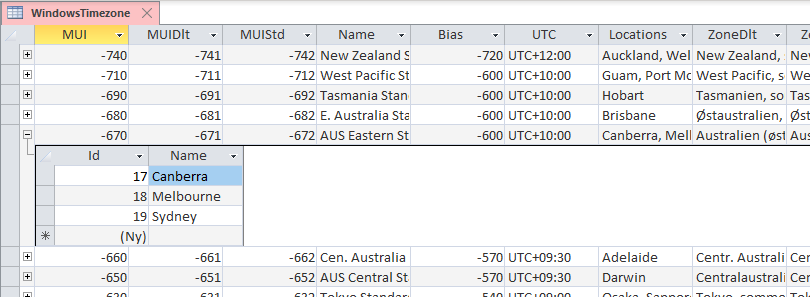
Having these tables as a source, all sorts of filtering, querying, and lookups will become trivial.
Do note, that if you wish to find the Daylight Saving Time (DST) bias for a date, you can check the values for FirstEntry and LastEntry to see if DST is applied for the time zone and, if so, in which range of years the parameters for DST have been changed:
- If FirstEntry is Null or after the year you wish to look up, DST was not introduced
- If the year to look up falls between FirstEntry and LastEntry, you must look up the bias specifically for the year
- If LastEntry is Null or earlier than the year you wish to look up, the current bias is the value to use
Presenting the time zones and their bias in Microsoft Excel
In Excel, something similar to what we did above in Access can be achieved as well, though in a very different way: A combination of formulas, code, and ListObject tables can be used to replace the callback function and the data tables.
Worksheet with tables
The first step is to create a worksheet holding the data, and ListObject tables are ideal for the purpose.As above for Access, this can be done completely from code rather than creating the tables manually. I can strongly recommend this method, as it is a huge time saver in case you wish to modify the data worksheet and table structure.
First, we need a set of constants to not mess up the code:
' Timezone worksheet name.
Private Const TimezoneWorksheetName As String = "Data"
' Timezone table names.
Private Const TimezoneTableZone As String = "WindowsTimezone"
Private Const TimezoneTableLocation As String = "WindowsTimezoneLocation"
' Timezone table positions.
Private Const TimezoneRowIndex As Integer = 1
Private Const TimezoneIndex As Integer = 1
Private Const TimezoneLocationIndex As Integer = 14
' Timezone field names.
' A field for the Registry key TZI is not included.
Private Const TimezoneMui As String = "MUI"
Private Const TimezoneMuiDaylight As String = "MUIDlt"
Private Const TimezoneMuiStandard As String = "MUIStd"
Private Const TimezoneBias As String = "Bias"
Private Const TimezoneName As String = "Name"
Private Const TimezoneUtc As String = "UTC"
Private Const TimezoneLocations As String = "Locations"
Private Const TimezoneDlt As String = "ZoneDlt"
Private Const TimezoneStd As String = "ZoneStd"
Private Const TimezoneFirstEntry As String = "FirstEntry"
Private Const TimezoneLastEntry As String = "LastEntry"
Private Const TimezoneDisplay As String = "Display"
Private Const TimezoneLocationId As String = "Id"
Private Const TimezoneLocationMui As String = "MUI"
Private Const TimezoneLocationName As String = "Name"' Look up and return the worksheet holding the timezone tables.
' If not found, the worksheet will be created.
'
' 2020-03-01. Gustav Brock. Cactus Data ApS, CPH.
'
Public Function WorksheetData() As Excel.Worksheet
Dim Worksheet As Excel.Worksheet
Dim Index As Integer
On Error GoTo WorksheetData_Error
Index = WorksheetIndex(ThisWorkbook, TimezoneWorksheetName)
If Index = 0 Then
Set Worksheet = ThisWorkbook.Worksheets.Add(, ThisWorkbook.Worksheets(ThisWorkbook.Worksheets.Count))
Worksheet.Name = TimezoneWorksheetName
RenameWorksheetModule ThisWorkbook, Worksheet.Index, TimezoneWorksheetName
Else
Set Worksheet = ThisWorkbook.Worksheets(Index)
End If
Set WorksheetData = Worksheet
WorksheetData_Exit:
Exit Function
WorksheetData_Error:
MsgBox "Error " & Err.Number & " (" & Err.Description & ") in procedure WxslData.WorksheetData."
Resume WorksheetData_Exit
End Function' Fill the timezone tables from the Windows Registry.
' They will be ordered by their bias and list of localised locations.
' Returns True, if the tables were successfully filled.
'
' If the worksheet does not exist, it will be created.
' If the tables don't exist, they will be create of no other tables are present.
'
' 2020-03-01. Gustav Brock. Cactus Data ApS, CPH.
'
Public Function ReloadTimezones() As Boolean
Dim Worksheet As Excel.Worksheet
Dim TimezoneList As Excel.ListObject
Dim LocationList As Excel.ListObject
Dim ListColumn As Excel.ListColumn
Dim Range As Excel.Range
Dim Entries() As TimezoneEntry
Dim Items() As String
Dim Entry As TimezoneEntry
Dim Index As Integer
Dim SubIndex As Integer
Dim Id As Integer
Dim Result As Boolean
On Error GoTo ReloadTimezones_Error
Entries = RegistryTimezoneItems()
SortEntriesBiasLocations Entries
Set Worksheet = WorksheetData
If Not Worksheet Is Nothing Then
If Worksheet.ListObjects.Count = 0 Then
' Worksheet exists but has no tables.
' Create the tables.
CreateTimezoneData
Else
' Do not overwrite existing tables.
End If
If IsListObject(Worksheet, TimezoneTableZone) And IsListObject(Worksheet, TimezoneTableLocation) Then
' Tables exist in the worksheet.
' Clear their content if they priviously have been filled.
Set LocationList = Worksheet.ListObjects(TimezoneTableLocation)
If Not LocationList.DataBodyRange Is Nothing Then
LocationList.DataBodyRange.Delete
End If
Set TimezoneList = Worksheet.ListObjects(TimezoneTableZone)
If Not TimezoneList.DataBodyRange Is Nothing Then
TimezoneList.DataBodyRange.Delete
End If
' Fill the tables row by row..
For Index = LBound(Entries) To UBound(Entries)
' Add and fill a row for a timezone.
Set Range = TimezoneList.ListRows.Add().Range
Entry = Entries(Index)
Range(1, 1) = Entry.Mui
Range(1, 2) = Entry.MuiDaylight
Range(1, 3) = Entry.MuiStandard
Range(1, 4) = Entry.Name
Range(1, 5) = Entry.Bias
Range(1, 6) = Entry.Utc
Range(1, 7) = Entry.Locations
Range(1, 8) = Entry.ZoneDaylight
Range(1, 9) = Entry.ZoneStandard
Range(1, 10) = Entry.FirstEntry
Range(1, 11) = Entry.LastEntry
' The formatted column for display and validation.
Range(1, 12) = FormatBias(Entry.Bias, True, True, Entry.Name) & " " & Entry.Locations
' Add and fill rows for the locations of the timezone.
Items = Split(Entry.Locations, ",")
For SubIndex = LBound(Items) To UBound(Items)
If Trim(Items(SubIndex)) <> "" Then
Set Range = LocationList.ListRows.Add().Range
Id = Id + 1
Range(1, 1) = Id
Range(1, 2) = Entry.Mui
Range(1, 3) = Trim(Items(SubIndex))
End If
Next
Next
Result = True
' Adjust column widths for both tables to fit the content.
For Index = 1 To TimezoneList.ListColumns.Count
Set ListColumn = TimezoneList.ListColumns(Index)
ListColumn.Range.EntireColumn.AutoFit
Next
For Index = 1 To LocationList.ListColumns.Count
Set ListColumn = LocationList.ListColumns(Index)
ListColumn.Range.EntireColumn.AutoFit
Next
Else
' No tables (ListObjects) to fill.
End If
End If
ReloadTimezones = Result
ReloadTimezones_Exit:
Exit Function
ReloadTimezones_Error:
MsgBox "Error " & Err.Number & " (" & Err.Description & ") in procedure WxlsData.ReloadTimezones."
Resume ReloadTimezones_Exit
End Function' Create and prepare a worksheet to hold the tables for the timezones.
' Returns True if the worksheet and tables existed or were created.
'
' 2020-03-01. Gustav Brock. Cactus Data ApS, CPH.
'
Public Function CreateTimezoneData() As Boolean
Dim Worksheet As Excel.Worksheet
Dim Result As Boolean
' Fetch or create the worksheet holding the tables.
Set Worksheet = WorksheetData
If Not Worksheet Is Nothing Then
' Check that the tables are present. If not, they will be created.
Result = CreateTimezoneDataTable(Worksheet, TimezoneTableZone)
If Result = True Then
Result = CreateTimezoneDataTable(Worksheet, TimezoneTableLocation)
End If
End If
CreateTimezoneData = Result
End Function
' Create and prepare a table for the timezones.
' Returns True if the table existed or were created.
'
' 2020-03-01. Gustav Brock. Cactus Data ApS, CPH.
'
Public Function CreateTimezoneDataTable( _
ByRef Worksheet As Excel.Worksheet, _
ByVal TableName As String) _
As Boolean
Dim ListObject As Excel.ListObject
Dim Range As Excel.Range
Dim ListColumn As Excel.ListColumn
Dim ColumnNames As Variant
Dim ColumnIndex As Integer
Dim Result As Boolean
On Error GoTo CreateTimezoneDataTable_Error
Select Case TableName
Case TimezoneTableZone
Set Range = Worksheet.Cells(TimezoneRowIndex, TimezoneIndex)
Case TimezoneTableLocation
Set Range = Worksheet.Cells(TimezoneRowIndex, TimezoneLocationIndex)
End Select
If Not IsListObject(Worksheet, TableName) Then
' Create the table.
Set ListObject = Worksheet.ListObjects.Add(xlSrcRange, Range, , xlYes)
ListObject.Name = TableName
Select Case TableName
Case TimezoneTableZone
ColumnNames = Array( _
TimezoneMui, _
TimezoneMuiDaylight, _
TimezoneMuiStandard, _
TimezoneName, _
TimezoneBias, _
TimezoneUtc, _
TimezoneLocations, _
TimezoneDlt, _
TimezoneStd, _
TimezoneFirstEntry, _
TimezoneLastEntry, _
TimezoneDisplay)
Case TimezoneTableLocation
ColumnNames = Array( _
TimezoneLocationId, _
TimezoneLocationMui, _
TimezoneLocationName)
End Select
For ColumnIndex = LBound(ColumnNames) + 1 To UBound(ColumnNames)
ListObject.ListColumns.Add
Next
For ColumnIndex = LBound(ColumnNames) To UBound(ColumnNames)
Set ListColumn = ListObject.ListColumns(ColumnIndex + 1)
ListColumn.Name = ColumnNames(ColumnIndex)
ListColumn.Range.EntireColumn.AutoFit
Next
' The table was created.
Result = True
Else
' The table is present.
Result = True
End If
CreateTimezoneDataTable = Result
CreateTimezoneDataTable_Exit:
Exit Function
CreateTimezoneDataTable_Error:
MsgBox "Error " & Err.Number & " (" & Err.Description & ") in procedure WxlsData.CreateTimezoneDataTable."
Resume CreateTimezoneDataTable_Exit
End FunctionThe first table holding the time zones will appear similar to this using the localisation of your Excel installation:
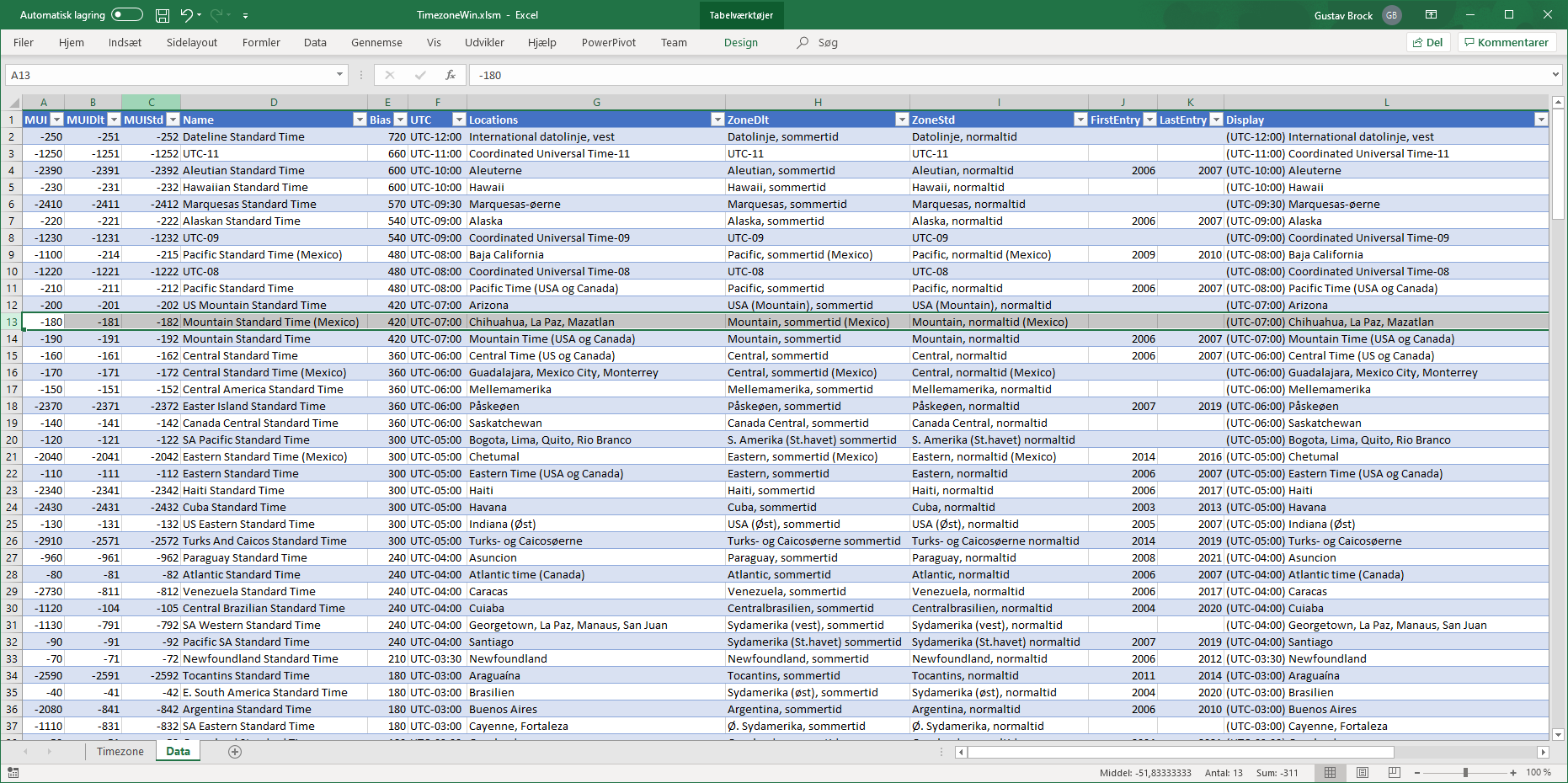
The other table holding the locations has only a few columns:
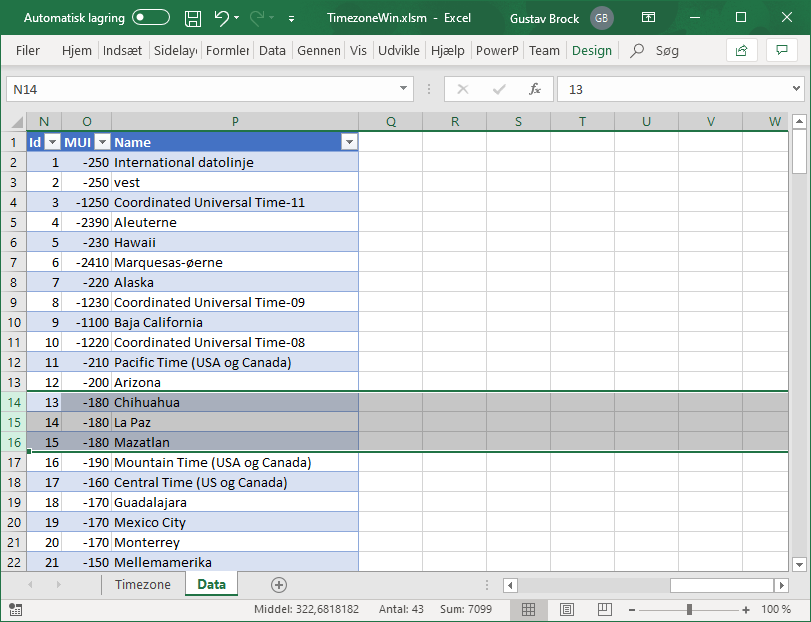
Worksheet for presentation
Next step to prepare for the presentation of the time zones, is to create a collection of Named Ranges in addition to those already created for the tables: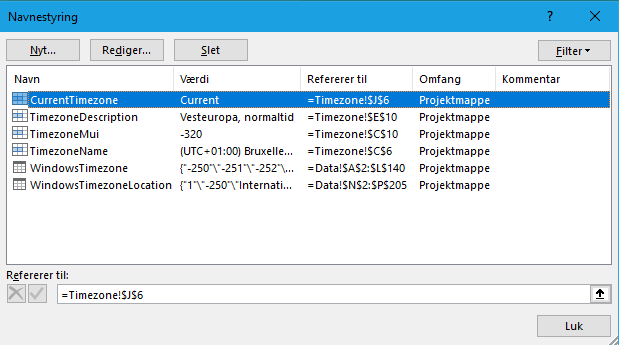
The first, CurrentTimezone, is for a "pseudo button" which - when selected - will retrieve the current time zone for display.
The two next are for the cells that will display information for the time zone selected by the value entered in the cell which TimezoneName refers to.
To make that cell appear as a ComboBox, data validation is applied:
- Select the timezone cell
- Select "Data Validation" from the band
- First tab: Select "List" and set mark for displaying a ComboBox (the red box)
- Input the formula for where to look up the values (the Display column in the table):
=INDIRECT("WindowsTimezone[Display]")- Last tab: Adjust type, title, and message as to your liking
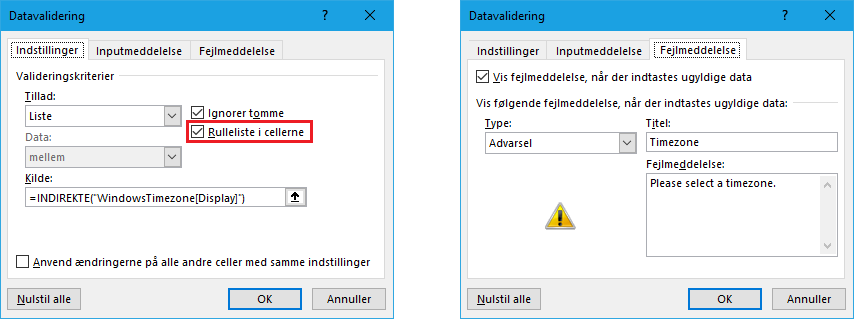
When ready, create formulas for the two display cells, TimezoneMUI and TimezoneDescription respectively:
=INDEX(WindowsTimezone[MUI];MATCH(TimezoneName;WindowsTimezone[Display];0))
=INDEX(WindowsTimezone[ZoneStd];MATCH(TimezoneName;WindowsTimezone[Display];0))' Have a cell select to simulate a button click.
'
Private Sub Worksheet_SelectionChange(ByVal Target As Range)
' Named Range used as "button".
Const ButtonName As String = "CurrentTimezone"
' Named Range holding the timezone name (the key).
Const TimezoneName As String = "TimezoneName"
Dim ButtonRange As Excel.Range
Dim NameRange As Excel.Range
Set ButtonRange = ThisWorkbook.Names(ButtonName).RefersToRange
Set NameRange = ThisWorkbook.Names(TimezoneName).RefersToRange
If Target.Address = ButtonRange.Address Then
' The user has selected the "button" and only this.
' Set the timezone to the current timezone displayed in "Windows style".
NameRange.Value = FormatBias(TimezoneCurrent.Bias, True, True, TimezoneCurrent.Name) & " " & TimezoneCurrent.Locations
' Reset formulas if needed.
ResetReferences
End If
End Sub' Reset the formulas for the timezone look up cells
' if the references for these have been lost.
'
Private Sub ResetReferences()
Const MuiName As String = "TimezoneMui"
Const DescriptionName As String = "TimezoneDescription"
Const MuiFormula As String = "=INDEX(WindowsTimezone[MUI],MATCH(TimezoneName,WindowsTimezone[Display],0))"
Const DescriptionFormula As String = "=INDEX(WindowsTimezone[ZoneStd],MATCH(TimezoneName,WindowsTimezone[Display],0))"
Dim MuiRange As Excel.Range
Dim DescriptionRange As Excel.Range
Set MuiRange = ThisWorkbook.Names(MuiName).RefersToRange
Set DescriptionRange = ThisWorkbook.Names(DescriptionName).RefersToRange
If MuiRange.Formula <> MuiFormula Then
MuiRange.Formula = MuiFormula
End If
If DescriptionRange.Formula <> DescriptionFormula Then
DescriptionRange.Formula = DescriptionFormula
End If
End Sub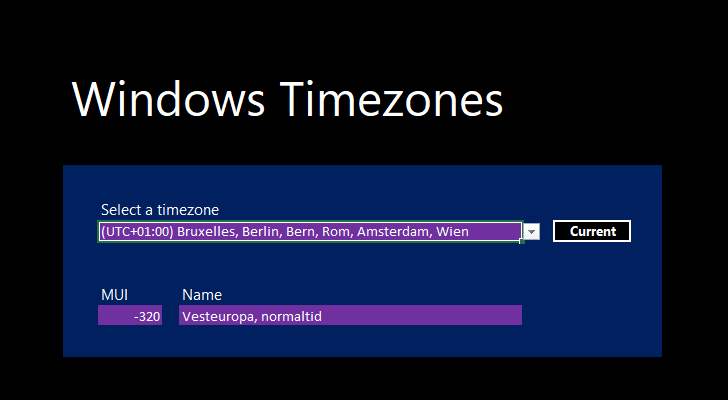
and with the dropdown activated - having the dull design of Excel you cannot control:
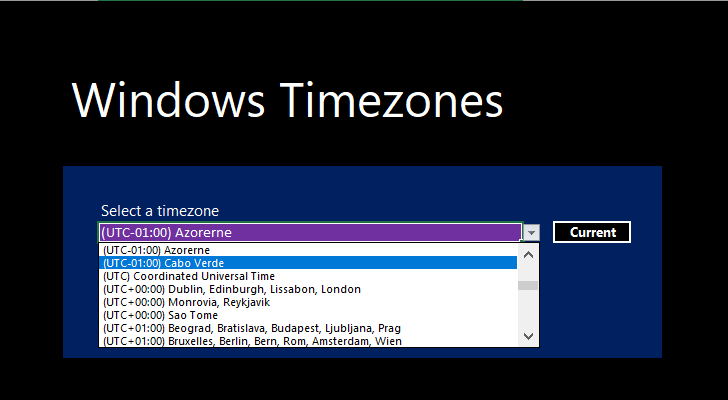
Conclusion
Having taken advantage of the collection of functions from the first article, it has been demonstrated how to store and display information in Microsoft Access and Excel about time zones retrieved from the Windows Registry without any third-party tools or need for supplemental information.
Also, some methods for optimising the user interface to meet the expectations of a demanding user has been shown.
Finally, sample applications ready to use have been attached for those who wish at once to be familiar with the concepts or to be used as a skeleton for parts of other applications.
Code and download
The full code and demos are attached for Microsoft Access 365 and Microsoft Excel 365.
Microsoft Access: TimezoneWin.accdb
Microsoft Excel: TimezoneWin.xlsm
At any time, full and updated code is available on GitHub: VBA.Timezone-Windows
I hope you found this article useful. You are encouraged to ask questions, report any bugs or make any other comments about it below.
Note: If you need further "Support" about this topic, please consider using the Ask a Question feature of Experts Exchange. I monitor questions asked and would be pleased to provide any additional support required in questions asked in this manner, along with other EE experts.
Please do not forget to press the "Thumbs Up" button if you think this article was helpful and valuable for EE members.

Have a question about something in this article? You can receive help directly from the article author. Sign up for a free trial to get started.


Comments (0)